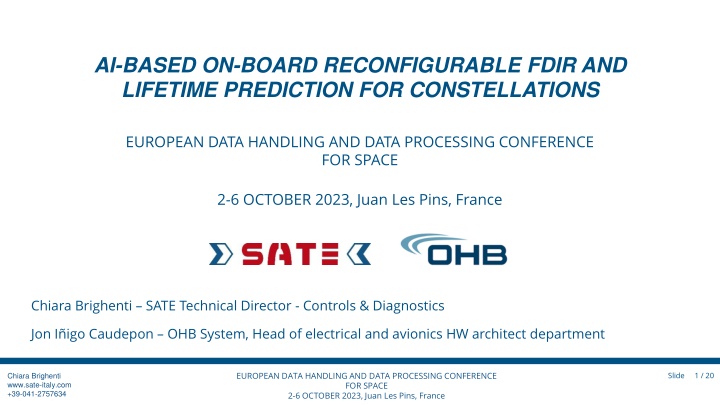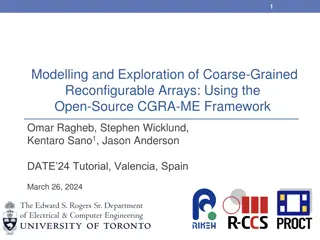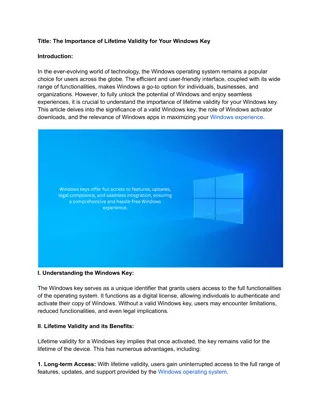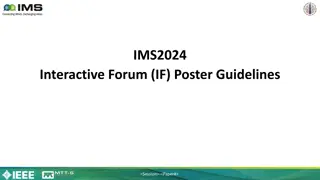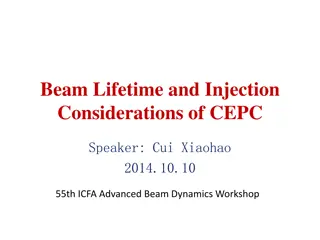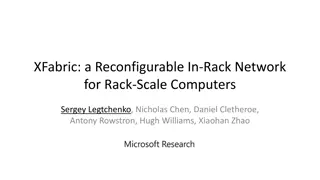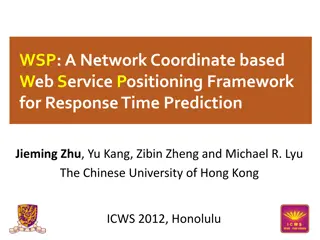AI-Based On-Board Reconfigurable FDIR and Lifetime Prediction for Constellations
This presentation discusses implementing AI-based enhanced FDIR and prognostics on-board solutions for constellations to improve fault detection, root cause analysis, and failure prediction, aiming to enhance service availability and reduce operational costs.
Download Presentation

Please find below an Image/Link to download the presentation.
The content on the website is provided AS IS for your information and personal use only. It may not be sold, licensed, or shared on other websites without obtaining consent from the author.If you encounter any issues during the download, it is possible that the publisher has removed the file from their server.
You are allowed to download the files provided on this website for personal or commercial use, subject to the condition that they are used lawfully. All files are the property of their respective owners.
The content on the website is provided AS IS for your information and personal use only. It may not be sold, licensed, or shared on other websites without obtaining consent from the author.
E N D
Presentation Transcript
AI-BASED ON-BOARD RECONFIGURABLE FDIR AND LIFETIME PREDICTION FOR CONSTELLATIONS EUROPEAN DATA HANDLING AND DATA PROCESSING CONFERENCE FOR SPACE 2-6 OCTOBER 2023, Juan Les Pins, France Chiara Brighenti SATE Technical Director - Controls & Diagnostics Jon I igo Caudepon OHB System, Head of electrical and avionics HW architect department EUROPEAN DATA HANDLING AND DATA PROCESSING CONFERENCE FOR SPACE 2-6 OCTOBER 2023, Juan Les Pins, France Slide 1 / 20 Chiara Brighenti www.sate-italy.com +39-041-2757634
Motivation & Objectives Constellations require complex operations and must grant high service availability. Autonomy and enhanced on-board FDIR are key to reduce ops costs and reaction time to events. This work defines and demonstrates a completereusable workflow to implement, deploy and maintain an AI-based enhanced FDIR and prognostics on-board solution to improve current FDIR systems in terms of: Early detection of incipient faults, Early identification of possible root causes, Identification of multiple unrelated yet concurrent faults, Time to failure prediction EUROPEAN DATA HANDLING AND DATA PROCESSING CONFERENCE FOR SPACE 2-6 OCTOBER 2023, Juan Les Pins, France Slide 2 / 19 Chiara Brighenti www.sate-italy.com +39-041-2757634
Technology transfer - CLUE RAW DATA CLUE is a customisable software library developed by SATE TRL 9 reached in automotive applications for on-board and off-board predictive maintenance of fleets of vehicles. Used in prototype applications for specific use cases in constellations. Diagnostic Kernel Module Prognostic Kernel Module Troubleshoot ing Kernel Module RECOVERY ACTIONS PREVENTIVE ACTIONS SELECTED RECOVERY ACTION SELECTED PREVENTIVE ACTION EUROPEAN DATA HANDLING AND DATA PROCESSING CONFERENCE FOR SPACE 2-6 OCTOBER 2023, Juan Les Pins, France Slide 3 / 19 Chiara Brighenti www.sate-italy.com +39-041-2757634
CLUE kernel modules RAW DATA Diagnostic Kernel Modules Health Index and early fault detection by model- based or AI-based methods Diagnostic Kernel Module Health Index Comp. 3 Prognostic Kernel Module Health Index Comp. 2 Health Index Comp. 1 Troubleshoot ing Kernel Module Health index Nominal Alert threshold Critical event or failures RECOVERY ACTIONS PREVENTIVE ACTIONS Highly anomalous Time SELECTED RECOVERY ACTION SELECTED PREVENTIVE ACTION EUROPEAN DATA HANDLING AND DATA PROCESSING CONFERENCE FOR SPACE 2-6 OCTOBER 2023, Juan Les Pins, France Slide 4 / 19 Chiara Brighenti www.sate-italy.com +39-041-2757634
CLUE kernel modules RAW DATA Troubleshooting Kernel Modules Correlated events and root cause Diagnostic Kernel Module Root cause Prognostic Kernel Module RW ELECTRONICS OTHER POSSIBLE CAUSES FAILURE INCREASED RW BEARING FRICTION FUEL INJECTOR FAILURE Troubleshoot ing Kernel Module RECOVERY ACTIONS PREVENTIVE ACTIONS RW BEARING TEMPERATURE SENSOR TEMPERATURE SENSOR FAILURE FAILURE SELECTED RECOVERY ACTION SELECTED PREVENTIVE ACTION EUROPEAN DATA HANDLING AND DATA PROCESSING CONFERENCE FOR SPACE 2-6 OCTOBER 2023, Juan Les Pins, France Slide 5 / 19 Chiara Brighenti www.sate-italy.com +39-041-2757634
CLUE kernel modules RAW DATA Prognostic Kernel Modules Health status trends and Remaining Useful Life Diagnostic Kernel Module RUL Prognostic Kernel Module Nominal Alert threshold HI [--] Troubleshoot ing Kernel Module Failure prediction uncertainty bounds Highly anomalous RECOVERY ACTIONS PREVENTIVE ACTIONS Elapsed operating time [h] DKM prediction of failure or critical event SELECTED RECOVERY ACTION SELECTED PREVENTIVE ACTION EUROPEAN DATA HANDLING AND DATA PROCESSING CONFERENCE FOR SPACE 2-6 OCTOBER 2023, Juan Les Pins, France Slide 6 / 19 Chiara Brighenti www.sate-italy.com +39-041-2757634
System recovery AI-based FDIR will select one recovery from a set of actions defined by the system engineers List of possible actions based on the identified most likely root-causes of the detected anomaly condition Some recovery/preventive actions may require approval/validation by ground operators Recovery action can be proposed in a partially automated way EUROPEAN DATA HANDLING AND DATA PROCESSING CONFERENCE FOR SPACE 2-6 OCTOBER 2023, Juan Les Pins, France Slide 7 / 19 Chiara Brighenti www.sate-italy.com +39-041-2757634
AI-based FDIR training OPS DESIGN AIT EARLY & CONTEXT BASED DIAGNOSIS EARLY & CONTEXT BASED DIAGNOSIS INFERENCE INFERENCE LEARNING LEARNING SIM DATA AIT DATA OPS DATA EUROPEAN DATA HANDLING AND DATA PROCESSING CONFERENCE FOR SPACE 2-6 OCTOBER 2023, Juan Les Pins, France Slide 8 / 19 Chiara Brighenti www.sate-italy.com +39-041-2757634
Implementation path PRODUCTION CUSTOMISATION VALIDATION AI-based FDIR Cust V. 1 AI-based FDIR Cust V. 2 AI-based FDIR Cust V. 2.1 SOLUTION REFINEMENTS CUSTOMISED SOLUTION CONSOLIDATED SOLUTION WHOLE VALIDATION SATS EXAMPLE SATS CONSTELLATION EUROPEAN DATA HANDLING AND DATA PROCESSING CONFERENCE FOR SPACE 2-6 OCTOBER 2023, Juan Les Pins, France Slide 9 / 19 Chiara Brighenti www.sate-italy.com +39-041-2757634
AOCS User needs Early detection of Reaction wheel anomalies, primarily related to the bearing unit or lubrication Isolation of potential root-cause (e.g.: electronics vs bearing) Early identification and prediction of degradation even when observables are behaving within normal range EUROPEAN DATA HANDLING AND DATA PROCESSING CONFERENCE FOR SPACE 2-6 OCTOBER 2023, Juan Les Pins, France Slide 10 / 19 Chiara Brighenti www.sate-italy.com +39-041-2757634
EPS User needs Early detection of Solar Array driver related anomalies (i.e. before a certain offset on the angular mismatch is reached). Identification of the source(s) of the anomaly and optimal recovery action, e.g.: switch over Drive control unit, command the SADM at a different speed to recover angular position or apply boost mode commanding for increased torque. Autonomous Identification of anomalies in the Recharge profiles, potentially related to SA performance or Battery degradation. Prediction of the Time to failure. EUROPEAN DATA HANDLING AND DATA PROCESSING CONFERENCE FOR SPACE 2-6 OCTOBER 2023, Juan Les Pins, France Slide 11 / 19 Chiara Brighenti www.sate-italy.com +39-041-2757634
SC avionics architecture Options for the AI-based FDIR SW on-board implementation: - Central CPU - a co-Processor module in the central OBC - a distributed high performance processor communicating with the central OBC via SpW or SpF interfaces EUROPEAN DATA HANDLING AND DATA PROCESSING CONFERENCE FOR SPACE 2-6 OCTOBER 2023, Juan Les Pins, France Slide 12 / 19 Chiara Brighenti www.sate-italy.com +39-041-2757634
Envisaged suitable HW Beyond Gravity Lynx single board computer or its GR740 variant Oryx SBC (depending on the Mission characteristics) are considered promising candidates for the targeted application. Lynx Key Features ARM processor with 4 x CPU cores >30000 DMIPS 4/8 GiByte DDR4 processing memory with ECC 44 GiByte usable Flash memory with ECC (EOL) 512 MiByte DDR2 communication memory with ECC Benchmark: ~50% faster than Raspberry Pi 4 (quad core ARM, 1.5 GHz) Oryx Key Features 6U cPCIss (ADHA) GR740 Quad Core LEON processor (1700 DMIPS) 512 MiB SDRAM RTG4 FPGA NAND Flash storage External: SpaceWire , M1553 and CAN Backplane: SpW and CAN. SerDes lanes in backplane, prepared for SpFi/PCIe EUROPEAN DATA HANDLING AND DATA PROCESSING CONFERENCE FOR SPACE 2-6 OCTOBER 2023, Juan Les Pins, France Slide 13 / 19 Chiara Brighenti www.sate-italy.com +39-041-2757634
Resource needs - RAM Estimates based on previous benchmark and following assumptions: 5 models are implemented in the AI-based FIDR All models generate the HI output at 1 s data rate Maximum instantaneous RAM required Module DKM I/O NN 10 kB FIM 2.06 MB RUL 5 kB Total 2.07 MB EUROPEAN DATA HANDLING AND DATA PROCESSING CONFERENCE FOR SPACE 2-6 OCTOBER 2023, Juan Les Pins, France Slide 14 / 19 Chiara Brighenti www.sate-italy.com +39-041-2757634
Resource needs ROM and Disk ROM/FLASH The executable software occupies less than 600 KB on ROM/Flash based on representative use cases developed in other applications. DISK STORAGE FOR 1 HOUR RECORDING Stored space Stored space Stored space Module @ 1 s @ 30 s 0.26 MB @ 60 s 0.14 MB DKM I/O NN 7.23 MB FIM 2 MB 0.05 MB 0.02 MB RUL 2.61 MB 0.08 MB 0.04 MB Total 11.84 MB 0.39 MB 0.2 MB The output data rate can be adjusted and flexible based on available memory and application requirements. EUROPEAN DATA HANDLING AND DATA PROCESSING CONFERENCE FOR SPACE 2-6 OCTOBER 2023, Juan Les Pins, France Slide 15 / 19 Chiara Brighenti www.sate-italy.com +39-041-2757634
Overall apportionment Overall Size (legacy OBC) Apportionment for AI application Benchmark from other applications Parameter Purpose/Content Storage of TMs, HIs & Modelled symptoms for a given observation window Real Time processing memory 43 Gb 350 Gb Mass memory 3 Gb 12 MB RAM memory 512 MB 32 MB 2 MB Context/SafeG uard memory Model variables/Tunable parametes 2 MB 50 KB 50 KB To allow for loading retrained or updated models during the mission lifetime, the Model variables (Tunable parameters) will be stored in the Context memory of the OBC. EUROPEAN DATA HANDLING AND DATA PROCESSING CONFERENCE FOR SPACE 2-6 OCTOBER 2023, Juan Les Pins, France Slide 16 / 19 Chiara Brighenti www.sate-italy.com +39-041-2757634
Data exchange rate Preliminary estimates derived from the following working assumptions shows that the required data rate between the Core module and Management module would be < 50kbps Floating Size (Bytes) Obs Rate (Hz) Parameter # Window (h) Models 5 Input parameters 6 (per model) 8 4 1 HI (Health Index) 1 (per model) 8 4 1 MV (Model Validity) 1 (per model) 8 4 1 MS (Model Symptoms) 5 (per model) 8 4 1 EUROPEAN DATA HANDLING AND DATA PROCESSING CONFERENCE FOR SPACE 2-6 OCTOBER 2023, Juan Les Pins, France Slide 17 / 19 Chiara Brighenti www.sate-italy.com +39-041-2757634
Conclusions This work describes an ongoing activity for the implementation of an enhanced AI-based FDIR on- board solution and the end-to-end workflow for its implementation and management throughout the constellation lifetime. The proposed approach benefits from previous experience in automotive applications of such AI-based fault detection and isolation solutions for large fleets of industrial vehicles, which share very similar needs and constraints as the satellites constellations scenarios. EUROPEAN DATA HANDLING AND DATA PROCESSING CONFERENCE FOR SPACE 2-6 OCTOBER 2023, Juan Les Pins, France Slide 18 / 19 Chiara Brighenti www.sate-italy.com +39-041-2757634
THANK YOU info@sate-italy.com Tel. +39-041-2757634 Santa Croce 664/A, 30135 Venezia EUROPEAN DATA HANDLING AND DATA PROCESSING CONFERENCE FOR SPACE 2-6 OCTOBER 2023, Juan Les Pins, France Slide 19 / 19 Chiara Brighenti www.sate-italy.com +39-041-2757634
